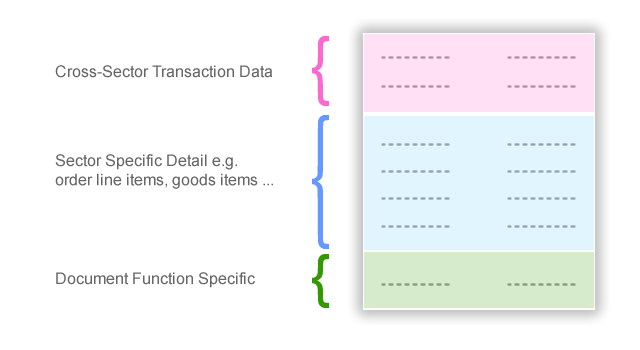UN Layout Key
The United Nations Layout Key is a model form that incorporates agreed specifications on paper size, margins, forms design sheet and presentation of data. It indicates places for the location of specific type of information (see image of the model form below).
UNLK is an essential part of the Document Alignment process as it provides templates for many trade documents. Originally the documents were designed to be used with carbonised paper so that as you were filling out one you were at least partially filling out others particularly if they were from the same families. Aligning documents to the UNLK would make sure that various documents use the same visual aspects (form, paper size, box design and location of boxes on the documents). The UNLK also ensures that parties use the same standard terms to aid filling in the forms.
The UN Layout Key was developed by the UNECE in the 1960s and published jointly with the UNECE Recommendation on the UNLK in 1973, and in 1981.

Application of the UNLK
Model form for layout keys, forms and masters
The UN Layout Key is not a document in itself. As a model form It is available for all implementors to reuse for developing other international or national layout keys, standardized forms, and national masters models. These other layout keys present data elements in accordance with the UNLK. According to the UN/CEFACT Recommendation No.1 sectoral layout keys direct the layout of further data elements that are common and specific to the special application or sector. Examples are: CCC Layout Keys for Goods Declarations (1965, 1977), ICS Standard Bill of Lading (1972). National layout keys present data elements in accordance with the UNLK which direct the layout of any further nationally-required data elements with a view to establishing national aligned series of trade documents. National layout keys (with or without national series of aligned forms) are often adopted as National Standards. Documents that are aligned to the UNLK are also developed for use at the company level. Here a compagny master document is developed that covers all relevant forms needed. Using the one-run method, all these documents that are used for regulatory purposes or for company intern requirements can be derived from the master document, that contains all relevant data, at the exact location.
There are some standardized forms that are aligned to the UNLK whose used has become mandatory; The Rail Consignment Note (1980) under the CIM Convention; or the TIR Carnet (1975) under the TIR Convention. There are also national standards forms that are aligned to the UNLK, such as national Customs declarations. The EU SAD has been design in accordance with the UNLK. Another example of application of the UNLK is the Aligned Invoice Layout Key presented in the UNECE Recommendation No.6 .
Key trade documents supported by the UNLK
As the UNLK was developed including data that was common for the majority of documents used in international trade, most of the key trade documents can be aligned to the UNLK. The Guidelines for application of the UNLK, published as informative annex to recommendation No. 1 provides a list of key documents prepared and used by stakeholders at different stages of the international supply chain. UNLK documents are categorises into document families such as:

These document sets, although separated in the Supply Chain Process by their functionality, have a similar structure, which helps to ensure that all documents are aligned.

Role for paperless trade
Despite the wide availability of the internet, there is still a need for aligned documents. Even if not filled in in manually, aligned documents are now more commonly part of the visualization process, which is still a requirement. Visualisation involves the viewing of mandatory elements at a specific stage of the supply chain. For instance the Single Administrative Document (SAD) is now fully automated in the EU. However, when required, systems can produce the SAD which is aligned with UNLK recommendations. The requirement for visualization will remain part of automated processing and whereas Authorities may be happy to look at a different layout presented on screen, if it needs to be printed, it is preferable to follow the standard layouts already in place. Therefore in electronic systems the paper oriented document sets can stil be part of the visualisation of the data exchange.
This is evident in the new EU Commission (Council Directive 2010/45/EU) VAT Directive, which comes into force across the EU in 2013 and requires the e-Invoice to be capable of visualisation as part of the auditing process. This is so that authorities and Auditors can easily check the mandatory elements of a message. Therefore from next year EU business will have no requirement for paper output as it is satisfactory that the document is visualised on a computer screen. If the system designers provide a screen layout suitable for printing then the user can print out a document when necessary.
* images Copyright Sue Probert SEPIAeb Ltd 1992-2012
